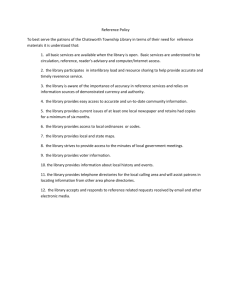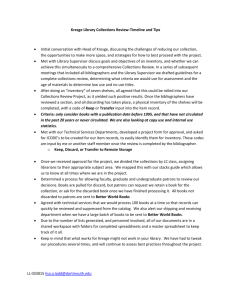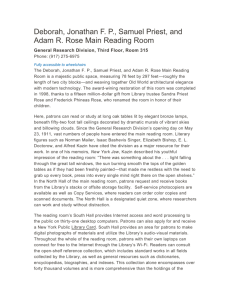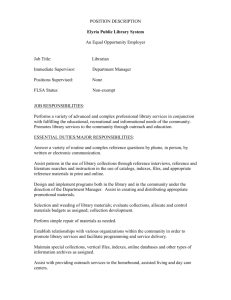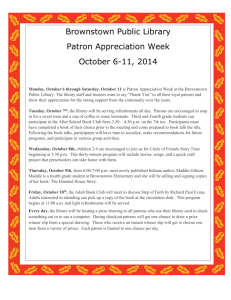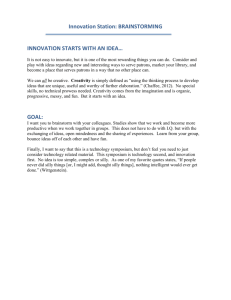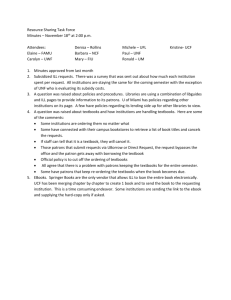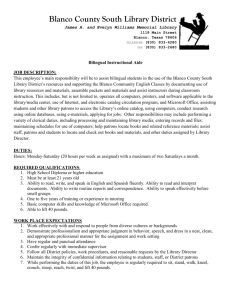INSTITUTIONAL EFFECTIVENESS
advertisement
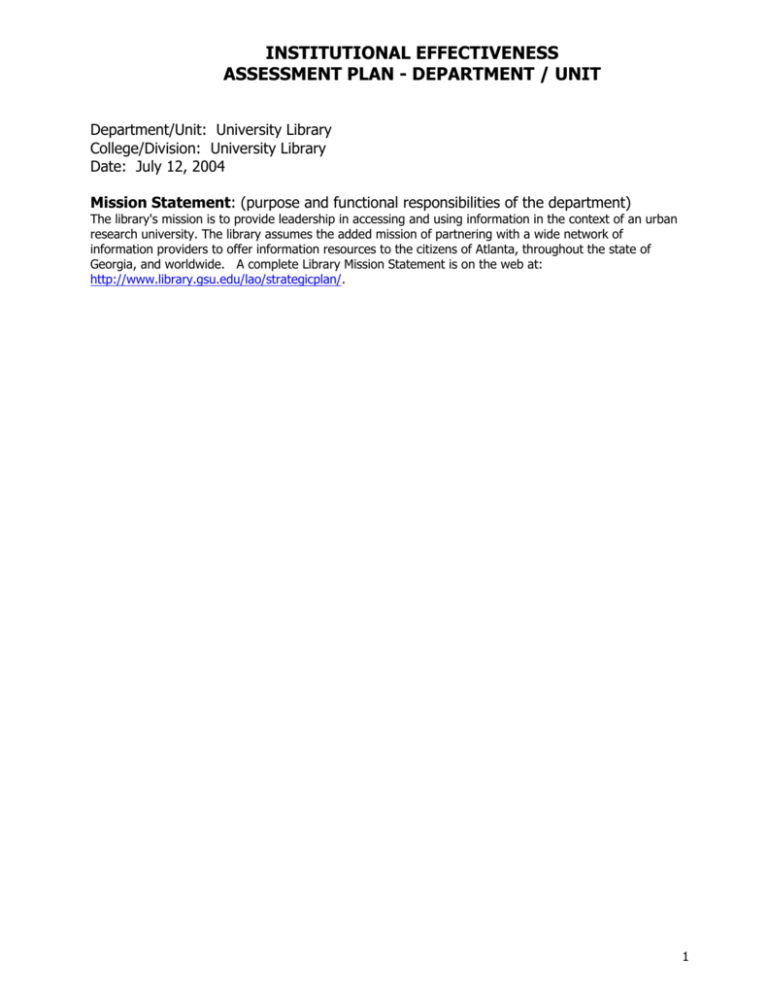
INSTITUTIONAL EFFECTIVENESS ASSESSMENT PLAN - DEPARTMENT / UNIT Department/Unit: University Library College/Division: University Library Date: July 12, 2004 Mission Statement: (purpose and functional responsibilities of the department) The library's mission is to provide leadership in accessing and using information in the context of an urban research university. The library assumes the added mission of partnering with a wide network of information providers to offer information resources to the citizens of Atlanta, throughout the state of Georgia, and worldwide. A complete Library Mission Statement is on the web at: http://www.library.gsu.edu/lao/strategicplan/. 1 Department/Unit: University Library Date: July 12, 2004 Intended Outcome # 1: Patrons have access to the appropriate information resources needed for learning and research. Effectiveness Indicators: Books, Journals and E-Resource purchases reflect the curricular needs of the university. Access is optimized through the use of technology tools and collection management. Success Criteria: Use of the collection increases at a benchmark of 5% per year and patrons are satisfied. A 10% drop in collection usage signals need to assess patrons’ needs. Library continuously improves access for patrons using innovative technology. New technology tools introduced to enhance user access to information resources are utilized by 20% of intended user population within first year. Lower statistics indicate need for stronger marketing campaign or cost benefit analysis. The average time from receipt of items to shelf to be reduced 5%. Data Collection and Analysis Procedures: Circulation Statistics, database usage statistics, reshelving statistics, E-Res statistics, etc., including LibQual survey. Compilation of patron complaints/requests. The Systems Office will report annually to Library Administration yearly changes in the number of users accessing new technology tools, such as ILLiad or SFX, to determine if the tool is being used by library patrons. Cataloging will sample the processing time of new materials and Circulation will sample reshelving time of returned items to ensure materials are optimally available to patrons. Library Administration will be notified if these departments are unable to meet the target set. Library Administration will analyze circulation statistics reported by Access & Media Services and the databases usage report provided by the Electronic Resources Librarian each year to determine if usage of the collection is increasing. Library Administration will initiate a LibQual survey every two years to determine the perception of patrons on the quality of resources. Utilization of Results: Adjustment in purchasing plans, subscription lists, databases, etc. The response of users to new technology evidenced by usage statistics will determine if more marketing of new technology tools is necessary and if the product should be retained. Staffing resources, collection management, and technology tools will be evaluated and adjusted. 2 Department/Unit: University Library Date: July 12, 2004 Intended Outcome # 2: Patrons have the help they need to make effective use of information resources. Effectiveness Indicators: Patrons make use of library faculty and staff expertise. Patrons use web-based research guides and tools. Faculty view the library as a partner in providing students with resources and skills to enhance learning. Success Criteria: Statistics relating to physical and virtual reference service, instruction, and consultations show an overall increase of 5%. Page hits for web-based research guides and tools show a 5% increase. Activities using library or information resources as part of course assignments show a yearly increase of 2%; each liaison librarian working with at least one research-intensive course per department (where applicable). Data Collection and Analysis Procedures: Information Services and Special Collections collect usage data for the physical and virtual reference, instruction sessions, and reference consultations and report them annually. Responses to Information Literacy questions in LibQUAL meet or exceed an average mean score of 6. Systems Office collects data on research guide page hits. Though increased web site hits on research guides may cause individual consultations to decline, the two sets of usage data together should increase. Liaisons will provide yearly instruction development reports as part of annual evaluation. Utilization of Results: Declines in usage statistics indicate a need to assess types of services and how they are promoted or offered. LibQUAL is administered and results analysis is used for planning. A decline or lack of activity/interaction in a specific department results in the liaison managers working with departmental liaisons to determine a strategy for improvement. Statistical findings prompt the use of focus groups to evaluate services. 3 Department/Unit: University Library Date: July 12, 2004 Intended Outcome # 3: Patrons have a library environment conducive to learning. Effectiveness Indicators: Library reasonably meets demand for individual and group study spaces. The quality of the facility (i.e. the physical environment) is in good condition. Multiple learning support services are available. Network access available at all seating areas in library via wireless or cabled access points. Success Criteria: Sampling shows the number of spaces being used 80-100% at peak times. Lower use signals a need for improved marketing. Building operations, finishes and furniture are in good working condition. The Library successfully partners with Writing Across the Curriculum, ESL and IS&T’s UETS. Network ports, wireless access and electrical coverage annually increase 10%. Data Collection and Analysis Procedures: Access Services will sample use of targeted spaces during 5 hours each day in the first weeks of October, November, February, and April. The LibQual Survey will assess student perceptions. Library Administration monitors building conditions and complaints at daily, monthly and annual intervals. Library Administration initiates focus groups on the Learning Commons. The Systems Office will annually report on the percentage of the library with wireless, cabled network, and electrical coverage. Utilization of Results: Study space usage patterns and satisfaction will factor into the development of the Library Transformation plans. Perceptions and feedback from patrons/staff will determine maintenance and replacement needs. Focus group feedback and regular partnership assessments will be used by Library Administration to plan staffing and services in the Learning Commons. Results will be used in planning network and electrical upgrades. 4 Department/Unit: University Library Date: July 12, 2004 Intended Outcome # 4: The university has a reputation that is enhanced through library activities. Effectiveness Indicators: Special Collections acquires collections of value to scholarship that have regional and/or national prestige. Library collaborates with other GSU units and external organizations or consortia, at both the institutional and individual levels (e.g. E-Res, ETDs, Institutional Repositories, Shibboleth, GALILEO). Library personnel present at conferences, publish articles and participate in scholarly and library activities. Potential faculty and students are recruited with information about excellent library support. University Library has larger pools of well qualified applicants. Library develops and maintains eligibility for membership in appropriate research library groups. Success Criteria: Acquired archival and special collections are made available and described online. Utilized collections are credited in publications, presentations or media productions. Gifts and donations increase by 10%. Numbers of Special Borrowers increase by 5% annually. Library faculty and staff are invited for speaking engagements, panel presentations and article submission to respected journals. Recruitment statistics show a 5% increase in well-qualified applicants. Library successfully fulfills the requirements for membership in the Association of Research Libraries. Data Collection and Analysis Procedures: Special Collections Department aggregates data annually on collection usage and monitors scholarly publications for cited collections. A 0% increase in gifts and donations signals need for reevaluation of donor strategies. Library Administration reviews partnerships annually to determine whether participation in respective organizations/consortia is beneficial to the Library and enhances the University’s reputation. Library Administration collects data at end of each fiscal year to record scholarly activity of library employees and applicant pools. ARL provides a template to determine application eligibility. That data will be collected by Library Administration. If ARL accepts initial application, a site visit will take place. Utilization of Results: Special Collections uses results to evaluate collecting policies and donor relations strategies, as well as to prioritize processing needs. Evaluation of local, regional and national partnerships/affiliations will indicate whether resources allocated to external organizations should increase, decrease or remain the same. Data will be used in strategic planning and reassessment of library mission and goals. Development strategies will be adjusted to reflect evaluation findings. If membership is denied because of deficiencies in library, remedial action will be taken. 5
